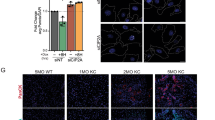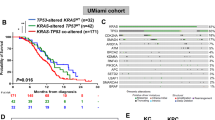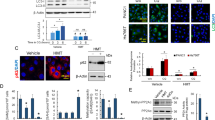Abstract
PP2A holoenzymes account nearly 50% of Ser/Thr phosphatase activities in human cells, yet their roles in oncogenesis remain largely unexplored. A PP2A holoenzyme consists of a catalytic subunit, a scaffold subunit, and a regulatory subunit. We previously reported that PR55α, a PP2A regulatory subunit, supports the tumorigenic and metastatic potential of pancreatic cancer cells, and this is associated with its role in promoting YAP activation, which is essential for tumorigenesis and progression in most solid tumors, including pancreatic cancer. However, the direct role of PR55α in tumorigenesis has not yet been assessed. Using telomerase-immortalized human pancreatic ductal cells (HPNE), this research reveals a mechanism in which PR55α/PP2A cooperates with oncogenic KRASG12D to drive cellular transformation and tumorigenesis in vivo. HPNE-transduced with PR55α and KRASG12D exhibited accelerated proliferation and migration, and anchorage-independent growth, hallmark features of malignant transformation. Biochemical studies demonstrated that PR55α-induced YAP activation was further enhanced by KRASG12D, primarily through the inhibition of the MST/LATS cascade. The essential role of YAP activation in HPNE transformation by PR55α and KRASG12D was confirmed by YAP inhibition. Finally, in vivo studies revealed that HPNE cells transformed by PR55α and KRASG12D were tumorigenic in mice. Collectively, these findings highlight the critical role of PR55α/PP2A in supporting KRAS-driven tumorigenesis, providing new insights into the mechanisms underlying pancreatic cancer progression.
This is a preview of subscription content, access via your institution
Access options
Subscribe to this journal
Receive 50 print issues and online access
$259.00 per year
only $5.18 per issue
Buy this article
- Purchase on SpringerLink
- Instant access to full article PDF
Prices may be subject to local taxes which are calculated during checkout








Similar content being viewed by others
Data availability
The data generated in this study are available within the article and its supplementary files or upon request from the corresponding author on reasonable request. The RNA-sequencing data from the Cancer Genome Atlas database/Pancreatic ductal adenocarcinoma cancer dataset (TCGA-PAAD) [55] was used for analyzing the correlation between PR55α or YAP mRNA expression and PC patient survival (Fig. 7B–D, Supplementary Table S1-S2). The mRNA level (FPKM) > 6.23 was considered high-PR55α expression, and the mRNA level (FPKM) > 19.12 was considered high-YAP expression in the PC specimens. The Kaplan-Meier survival analyses were performed using the online Kaplan-Meier Plotter program (www.kmplot.com) [58].
References
Hanahan D. Hallmarks of cancer: new dimensions. Cancer Discov. 2022;12:31–46.
Gnoni A, Licchetta A, Scarpa A, Azzariti A, Brunetti AE, Simone G, et al. Carcinogenesis of pancreatic adenocarcinoma: precursor lesions. International J Mol Sci. 2013;14:19731–62.
Almoguera C, Shibata D, Forrester K, Martin J, Arnheim N, Perucho M. Most human carcinomas of the exocrine pancreas contain mutant c-K-ras genes. Cell. 1988;53:549–54.
Redston MS, Caldas C, Seymour AB, Hruban RH, da Costa L, Yeo CJ, et al. p53 mutations in pancreatic carcinoma and evidence of common involvement of homocopolymer tracts in DNA microdeletions. Cancer Res. 1994;54:3025–33.
Ruvolo PP. The broken “Off” switch in cancer signaling: PP2A as a regulator of tumorigenesis, drug resistance, and immune surveillance. BBA Clin. 2016;6:87–99.
Eichhorn PJ, Creyghton MP, Bernards R. Protein phosphatase 2A regulatory subunits and cancer. Biochim Biophys Acta. 2009;1795:1–15.
Perrotti D, Neviani P. Protein phosphatase 2A: a target for anticancer therapy. Lancet Oncol. 2013;14:e229–238.
Nobumori Y, Shouse GP, Wu Y, Lee KJ, Shen B, Liu X. B56gamma tumor-associated mutations provide new mechanisms for B56gamma-PP2A tumor suppressor activity. Mol Cancer Res. 2013;11:995–1003.
Sablina AA, Hector M, Colpaert N, Hahn WC. Identification of PP2A complexes and pathways involved in cell transformation. Cancer Res. 2010;70:10474–84.
Yamamoto H, Hinoi T, Michiue T, Fukui A, Usui H, Janssens V, et al. Inhibition of the Wnt signaling pathway by the PR61 subunit of protein phosphatase 2A. J Biol Chem. 2001;276:26875–82.
Yang J, Phiel C. Functions of B56-containing PP2As in major developmental and cancer signaling pathways. Life Sci. 2010;87:659–66.
Mumby M. PP2A: unveiling a reluctant tumor suppressor. Cell. 2007;130:21–24.
Zhang L, Zhou H, Li X, Vartuli RL, Rowse M, Xing Y, et al. Eya3 partners with PP2A to induce c-Myc stabilization and tumor progression. Nature Commun. 2018;9:1047.
Reid MA, Wang WI, Rosales KR, Welliver MX, Pan M, Kong M. The B55alpha subunit of PP2A drives a p53-dependent metabolic adaptation to glutamine deprivation. Mol Cell. 2013;50:200–11.
Zhang W, Yang J, Liu Y, Chen X, Yu T, Jia J, et al. PR55 alpha, a regulatory subunit of PP2A, specifically regulates PP2A-mediated beta-catenin dephosphorylation. J Biol Chem. 2009;284:22649–56.
Adams DG, Coffee RL Jr, Zhang H, Pelech S, Strack S, Wadzinski BE. Positive regulation of Raf1-MEK1/2-ERK1/2 signaling by protein serine/threonine phosphatase 2A holoenzymes. J Biol Chem. 2005;280:42644–54.
Ory S, Zhou M, Conrads TP, Veenstra TD, Morrison DK. Protein phosphatase 2A positively regulates Ras signaling by dephosphorylating KSR1 and Raf-1 on critical 14-3-3 binding sites. Curr Biol. 2003;13:1356–64.
Madduri LSV, Brandquist ND, Palanivel C, Talmon GA, Baine MJ, Zhou S, et al. p53/FBXL20 axis negatively regulates the protein stability of PR55alpha, a regulatory subunit of PP2A Ser/Thr phosphatase. Neoplasia. 2021;23:1192–203.
Hein AL, Brandquist ND, Ouellette CY, Seshacharyulu P, Enke CA, Ouellette MM, et al. PR55alpha regulatory subunit of PP2A inhibits the MOB1/LATS cascade and activates YAP in pancreatic cancer cells. Oncogenesis. 2019;8:63.
Hein AL, Seshacharyulu P, Rachagani S, Sheinin YM, Ouellette MM, Ponnusamy MP, et al. PR55alpha subunit of protein phosphatase 2A supports the tumorigenic and metastatic potential of pancreatic cancer cells by sustaining hyperactive oncogenic signaling. Cancer Res. 2016;76:2243–53.
Kiely M, Kiely PA. PP2A: The Wolf in Sheep’s Clothing?. Cancers (Basel). 2015;7:648–69.
Sebio A, Lenz HJ. Molecular pathways: hippo signaling, a critical tumor suppressor. Clin Cancer Res. 2015;21:5002–7.
Dong J, Feldmann G, Huang J, Wu S, Zhang N, Comerford SA, et al. Elucidation of a universal size-control mechanism in Drosophila and mammals. Cell. 2007;130:1120–33.
Pan D. Hippo signaling in organ size control. Genes Dev. 2007;21:886–97.
Zanconato F, Cordenonsi M, Piccolo S. YAP/TAZ at the Roots of Cancer. Cancer Cell. 2016;29:783–803.
Kapoor A, Yao W, Ying H, Hua S, Liewen A, Wang Q, et al. Yap1 activation enables bypass of oncogenic Kras addiction in pancreatic cancer. Cell. 2014;158:185–97.
Shao DD, Xue W, Krall EB, Bhutkar A, Piccioni F, Wang X, et al. KRAS and YAP1 converge to regulate EMT and tumor survival. Cell. 2014;158:171–84.
Zhang W, Nandakumar N, Shi Y, Manzano M, Smith A, Graham G, et al. Downstream of mutant KRAS, the transcription regulator YAP is essential for neoplastic progression to pancreatic ductal adenocarcinoma. Sci Signal. 2014;7:ra42.
Yu FX, Guan KL. The Hippo pathway: regulators and regulations. Genes Dev. 2013;27:355–71.
Rozengurt E, Sinnett-Smith J, Eibl G. Yes-associated protein (YAP) in pancreatic cancer: at the epicenter of a targetable signaling network associated with patient survival. Signal Transduct Target Ther. 2018;3:11.
Ansari D, Ohlsson H, Althini C, Bauden M, Zhou Q, Hu D, et al. The hippo signaling pathway in pancreatic cancer. Anticancer Res. 2019;39:3317–21.
Hayashi H, Uemura N, Zhao L, Matsumura K, Sato H, Shiraishi Y, et al. Biological significance of YAP/TAZ in pancreatic ductal adenocarcinoma. Front Oncol (Rev). 2021;11:700315.
Praskova M, Xia F, Avruch J. MOBKL1A/MOBKL1B phosphorylation by MST1 and MST2 inhibits cell proliferation. Curr Biol. 2008;18:311–21.
Chan EH, Nousiainen M, Chalamalasetty RB, Schafer A, Nigg EA, Sillje HH. The Ste20-like kinase Mst2 activates the human large tumor suppressor kinase Lats1. Oncogene. 2005;24:2076–86.
Ni L, Zheng Y, Hara M, Pan D, Luo X. Structural basis for Mob1-dependent activation of the core Mst-Lats kinase cascade in Hippo signaling. Genes Dev. 2015;29:1416–31.
O’Neill E, Rushworth L, Baccarini M, Kolch W. Role of the kinase MST2 in suppression of apoptosis by the proto-oncogene product Raf-1. Science. 2004;306:2267–70.
Romano D, Nguyen LK, Matallanas D, Halasz M, Doherty C, Kholodenko BN, et al. Protein interaction switches coordinate Raf-1 and MST2/Hippo signalling. Nat Cell Biol. 2014;16:673–84.
Zinatizadeh MR, Miri SR, Zarandi PK, Chalbatani GM, Rapôso C, Mirzaei HR, et al. The Hippo Tumor Suppressor Pathway (YAP/TAZ/TEAD/MST/LATS) and EGFR-RAS-RAF-MEK in cancer metastasis. Genes Dis. 2021;8:48–60.
Lee KM, Choi KH, Ouellette MM. Use of exogenous hTERT to immortalize primary human cells. Cytotechnology. 2004;45:33–38.
Lee KM, Yasuda H, Hollingsworth MA, Ouellette MM. Notch 2-positive progenitors with the intrinsic ability to give rise to pancreatic ductal cells. Lab Invest. 2005;85:1003–12.
Song S, Xie M, Scott AW, Jin J, Ma L, Dong X, et al. A novel YAP1 inhibitor targets CSC-enriched radiation-resistant cells and exerts strong antitumor activity in esophageal adenocarcinoma. Molecular Cancer Therapeutics. 2018;17:443–54.
Campbell PM, Groehler AL, Lee KM, Ouellette MM, Khazak V, Der CJ. K-Ras promotes growth transformation and invasion of immortalized human pancreatic cells by Raf and phosphatidylinositol 3-kinase signaling. Cancer Res. 2007;67:2098–106.
Campbell PM, Lee KM, Ouellette MM, Kim HJ, Groehler AL, Khazak V, et al. Ras-driven transformation of human nestin-positive pancreatic epithelial cells. Methods Enzymol. 2008;439:451–65.
Palanivel C, Madduri LSV, Hein AL, Jenkins CB, Graff BT, Camero AL, et al. PR55alpha-controlled protein phosphatase 2A inhibits p16 expression and blocks cellular senescence induction by gamma-irradiation. Aging (Albany NY). 2024;16:4116–37.
Waters AM, Der CJ. KRAS: The critical driver and therapeutic target for pancreatic cancer. Cold Spring Harb Perspect Med. 2018;8:a031435.
Mebratu Y, Tesfaigzi Y. How ERK1/2 activation controls cell proliferation and cell death: Is subcellular localization the answer?. Cell Cycle. 2009;8:1168–75.
Nguyen LK, Matallanas DG, Romano D, Kholodenko BN, Kolch W. Competing to coordinate cell fate decisions: the MST2-Raf-1 signaling device. Cell Cycle. 2015;14:189–99.
Morton JP, Timpson P, Karim SA, Ridgway RA, Athineos D, Doyle B, et al. Mutant p53 drives metastasis and overcomes growth arrest/senescence in pancreatic cancer. Proc Natl Acad Sci USA. 2010;107:246–51.
Dimauro T, David G. Ras-induced senescence and its physiological relevance in cancer. Curr Cancer Drug Targets. 2010;10:869–76.
Thompson BJ. YAP/TAZ: drivers of tumor growth, metastasis, and resistance to therapy. Bioessays. 2020;42:e1900162.
Khan AA, Liu X, Yan X, Tahir M, Ali S, Huang H. An overview of genetic mutations and epigenetic signatures in the course of pancreatic cancer progression. Cancer Metastasis Rev. 2021;40:245–72.
Hu HF, Ye Z, Qin Y, Xu XW, Yu XJ, Zhuo QF, et al. Mutations in key driver genes of pancreatic cancer: molecularly targeted therapies and other clinical implications. Acta Pharm Sin. 2021;42:1725–41.
Zhu C, Ji X, Zhang H, Zhou Q, Cao X, Tang M, et al. Deubiquitylase USP9X suppresses tumorigenesis by stabilizing large tumor suppressor kinase 2 (LATS2) in the Hippo pathway. J Biol Chem. 2018;293:1178–91.
Meng Z, Moroishi T, Guan KL. Mechanisms of Hippo pathway regulation. Genes Dev. 2016;30:1–17.
Cerami E, Gao J, Dogrusoz U, Gross BE, Sumer SO, Aksoy BA, et al. The cBio cancer genomics portal: an open platform for exploring multidimensional cancer genomics data. Cancer Discov. 2012;2:401–4.
Eser S, Schnieke A, Schneider G, Saur D. Oncogenic KRAS signalling in pancreatic cancer. Br J Cancer. 2014;111:817–22.
Singh SK, Ellenrieder V. Senescence in pancreatic carcinogenesis: from signalling to chromatin remodelling and epigenetics. Gut. 2013;62:1364–72.
Győrffy B. Integrated analysis of public datasets for the discovery and validation of survival-associated genes in solid tumors. Innovation 2024;5:100625.
Acknowledgements
We thank M.S. Holzapfel and E. Eldridge for assistance with immunohistochemistry analysis in the Tissue Science Core of the University of Nebraska Medical Center. This work was supported, in parts, by grants NIH/R01GM143329 (YY), U.S. Army/USAMRAA/CDMRP/W81XWH-21-1-0700 (YY), a pilot project award from 5U54GM115458 (YY), Nebraska/DHHS (2022-59) (YY), and NIH/R01CA206444 (MMO).
Author information
Authors and Affiliations
Contributions
C.B.J.: Investigation, data curation, methodology, software, validation, visualization, participating in writing-original draft, writing-review & editing. A.L.C.: Participating in data curation, methodology, review. B.T.G.: Participating in data curation, methodology, review. L.S.V.M.: Participating in data curation, methodology. K.A.O.: Methodology, resources. A.L.H.: Pathology. L.M.S.: Statistics. C.A.E.: Resources, methodology. J.D.: Conceptualization, resources, methodology. M.A.H.: Conceptualization, resources, methodology. K.R.J.: Conceptualization, review-editing. M.M.O.: Resources, conceptualization, methodology, review-editing. Y.Y.: Conceptualization, supervision, Visualization, funding acquisition, project administration, writing-original draft, writing-review-editing.
Corresponding author
Ethics declarations
Competing interests
The authors declare no competing interests.
Ethics approval and consent to participate
All methods in this study were performed in accordance with the relevant guidelines and regulations. Animal care and experimental procedures were reviewed and approved by the University of Nebraska Medical Center-Institutional Animal Care and Use Committee (Protocol # 21-026-05-FC).
Additional information
Publisher’s note Springer Nature remains neutral with regard to jurisdictional claims in published maps and institutional affiliations.
Supplementary information
Rights and permissions
Springer Nature or its licensor (e.g. a society or other partner) holds exclusive rights to this article under a publishing agreement with the author(s) or other rightsholder(s); author self-archiving of the accepted manuscript version of this article is solely governed by the terms of such publishing agreement and applicable law.
About this article
Cite this article
Jenkins, C.B., Camero, A.L., Graff, B.T. et al. PR55α subunit of protein phosphatase 2A supports KRASG12D-driven tumorigenesis that requires YAP activation. Oncogene 44, 3070–3082 (2025). https://doi.org/10.1038/s41388-025-03477-y
Received:
Revised:
Accepted:
Published:
Issue date:
DOI: https://doi.org/10.1038/s41388-025-03477-y



